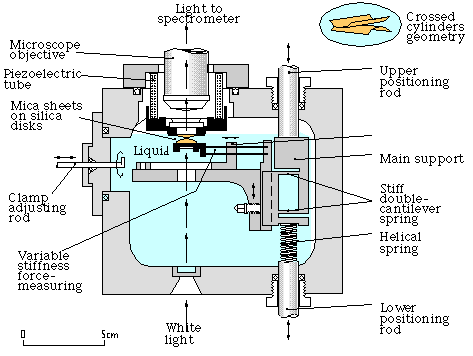 |
|
|
Mark-II
 |
| |
Applications: |
|
 |
- Forces
between surfaces in liquids or vapor
-
Forces between surfactant and polymer-coated surfaces
-
Interactions of model bio-surfaces such as lipid bilayers
-
Surface chemistry of metals, metal oxides, semiconductors
-
Adhesion between similar or dissimilar materials
-
Contact deformation
-
Wetting and capillary condensation
-
Viscosity and other flow processes in thin films
|
|
| |
This
Surface Forces Apparatus is capable of measuring the flow between two molecularly
smooth surfaces in vapors or liquids with a sensitivity of a few millidynes
(10nN) and a distance resolution of about 1A (0.1nm). It can also measure
the refractive index of the medium between the surfaces, adsorption, isotherms,
capillary condensation, dynamic and time-dependent phenomena, and surfaces
deformations arising from surface forces. Though mica surfaces are the primary
surfaces used for these measurements, it is possible to deposit or coat
these surfaces with surfactant, lipids, polymers, metals, etc., so as to
alter the nature and chemistry of the interacting surfaces while keeping
them smooth by virtue of the moleculary smooth mica substrate surface underneath.
|
|
| |
|
|
| The
SFA MK-II is an apparatus for measuring forces between two curved molecularly
smooth surfaces in liquids or vapors. The above figure also shows some of
the alternative force-measuring springs suitable for different types of
experiments. The basic Apparatus has a simple single-cantilever spring (not
shown here) |

|
|
| to
which the lower silica disk is attached. This drawing shows the assembled
apparatus with the 'variable stiffness spring' whose stiffness can be varied
by a factor of 1000 during experiments by shifting the position of the dove-tailed
'clamp' using the 'adjusting rod'. |
|
| |
|
|
| Click
on Image to enlarge. |
|
|
| |
|
|
Mark-III
 |
| |
|
|
| The
new surface forces apparatus (FSA Mk-III) is for measuring the forces between
two molecularly smooth surfaces. Mk-III employs four distance controls instead
of three as in the Mk-II. The four controls are: micrometer, differential
micrometer, different spring and piezoelectric tube. |

|
|
| The
mica surfaces are glued to cylindrical support disks of radius R and positioned
in a crossed cylinder geometry. The lower surface is mounted on a variable-stiffness
double-cantilever force-measuring spring within the lower chamber and is
connected to the upper (control) chamber via a Teflon bellow. |
| |
|
|
| Click
on Image to enlarge. |
|
|
| |
 |
 |
|
|







